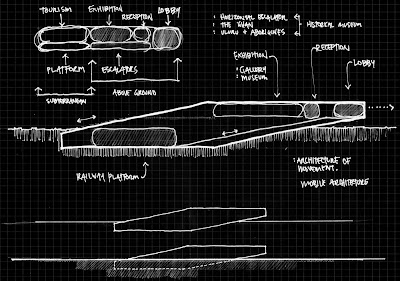Friday, 28 October 2011
Thursday, 27 October 2011
[13] Development
Upon further investigation into the context of the Australian Outback and more specifically, Alice Springs I have discovered that much of the population is located along the axis created by 'The Ghan' (railway line running from Darwin to Adelaide, through Alice Springs). On top of this, I found it interesting to note that the general population fluctuates quite severely and rapidly with tourism and major events within these areas:
Itinerant population:
"Alice Springs has a large itinerant population. This population is generally composed of foreign and Australian tourists, Australian Aborigines visiting from nearby Central Australian communities, and Australian or international workers on short-term contracts (colloquially referred to as "blow-ins"). The major sources of work that recruit workers into town are the stations and mines. Foreign tourists usually pass through on their way to Uluru-Kata Tjuta National Park, whilst Australian tourists usually come through as a part of an event such as the Masters Games and the Finke Desert Race. These events can cause the population of the town to fluctuate by several thousand within a matter of days."
Itinerant population:
"Alice Springs has a large itinerant population. This population is generally composed of foreign and Australian tourists, Australian Aborigines visiting from nearby Central Australian communities, and Australian or international workers on short-term contracts (colloquially referred to as "blow-ins"). The major sources of work that recruit workers into town are the stations and mines. Foreign tourists usually pass through on their way to Uluru-Kata Tjuta National Park, whilst Australian tourists usually come through as a part of an event such as the Masters Games and the Finke Desert Race. These events can cause the population of the town to fluctuate by several thousand within a matter of days."
Tuesday, 25 October 2011
Monday, 24 October 2011
Saturday, 22 October 2011
[12] Existing modes of desert transport
Now that the desert node has been located and conceptual planning is completed, a viable and efficient system of connecting communities in remote desert locations I began to research existing methods of movement across this hostile and vast landscape (see below). These modules which travel from these communities to the central outback capital are required to travel long distances over very difficult terrain.
Two levels of mobility:
- Railway infrastructure for long distance movement
- Secondary system of transporting people to/from railway line to remote location
All terrain vehicle - cross country
Train - railway system
Car and trailer - roadways and tracks
Tracked vehicles - cross country
Tuesday, 18 October 2011
Monday, 17 October 2011
Sunday, 16 October 2011
Thursday, 13 October 2011
Wednesday, 12 October 2011
[11] Exemplar
The arrangement of spaces featured in the winning proposal by
C. F. Møller Architects for the new terminal in stockholm generates an architectural form similar to that of my proposal. The layering of spaces employed in this project is a possible area for myself to investigate in my progressions.
[11] Further development
After further investigations into the context of Uluru-Kata Tjuta National Park I have begun to refine and restructure parts of the brief to allow the eventual architectural solution to be of much higher resolution.
With a more in depth knowledge base of this culturally, historically, climatically and geographically diverse context, I am beginning to formulate a stronger concept and direction for a mobile architectural proposal.
With a more in depth knowledge base of this culturally, historically, climatically and geographically diverse context, I am beginning to formulate a stronger concept and direction for a mobile architectural proposal.
Friday, 7 October 2011
Subscribe to:
Comments (Atom)
Mobile 2: Jane Foster
[All content displayed is individual work except where labelled]
















































